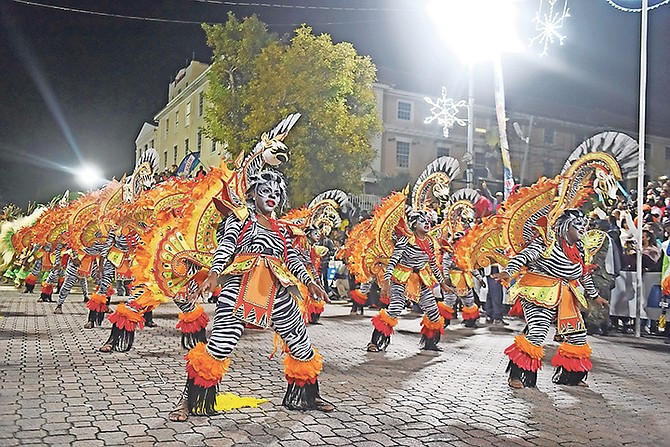The Valley Boys on Bay Street at the 2019 Junkanoo Boxing Day parade. Photo: Shawn Hanna/Tribune Staff
It is not a holiday season without Junkanoo. To miss the Valley, Roots, One Family and Saxons on Bay Street is to be asleep for the entire season. I spent the last two holiday seasons outside of The Bahamas, and I was thankful for the livestreams of the Junkanoo parades. Like watching on ZNS, it is not the same as being there, but at least I could see the costumes, feel the thrill that comes with the drums getting closer, become excited by the dips and spins of the choreographed dancers and hope for my favourite group to perform, perform, perform.
Being away for a couple of years must have made me forget how quickly the tickets for Rawson Square sell out. By the time I made it to the JCNP office, only Cabinet Parking was available for Boxing Day, so I took that and got a Rawson Square ticket for New Year’s Day. Most of the people in my section on Boxing Day were moderate fans of various groups, but a group of four people behind me was determined to let everyone know which group they supported. It did not help that one of them was rather inebriated. We endured shouts of “Y’all pretty! Y’all some pretty losers!” and “Man, get off Bay Street!” as the first set of groups made their way past us. It was funny to hear them encourage others to cheer “for the chirrens” of all groups. They shouted, “Good job!” and “You’s a smart girl! Good boy!” at children as they danced to very distant music. Being in the front is not easy but the children truly did a great job.
Is anything as unifying and as competitive as Junkanoo? We love this festival, this pageant, this revelry, this display of talent, this burst of colour, this heartbeat of Bay Street so much that we lose sleep, brave the “draft,” and laugh and argue with strangers over it. It is so fierce and its energy so overwhelming that even the onlookers compete.
Who is the loudest? Who has the most hurtful insults? Who has the best grasp of Junkanoo history? Who knows the most people in the group passing now? Who is most successful at getting others in the crowd to join in a chant? And these days, with sponsors sending swag teams up and down Bay Street, who will catch the most “free tings”?
On both Boxing Day and New Year’s Day, I was happy to be in the company of Bahamians deeply in love with one of the most glorious and intentional displays of Bahamian culture. I sat through the long gaps and did my best to appreciate the performance of dancers far ahead of the music rather than lament the missing element, obviously due to the size of the groups.
I tried to forgive the use of speakers in banners which gave dancers something to work with. I wanted to stay on the bright side. I could not help but notice, however, the large number of pieces that were not pasted. I was saddened to see the sparing use of crepe paper and the fairly new practice of decorating costumes in a manner that looks like stickers on cardboard accompanied by gems and feathers. It is not unattractive, but it is not the style I have always admired. Junkanoo has gone through many evolutions, and I wonder if this is another one that will stick. I also wonder if the introduction of Carnival has anything to do with it. I wonder what Junkanoo will look like in ten or 20 years, and if we will still be able to distinguish it from other parades and festivals.
Whatever the materials they use, the banners and costumers are always stunning. The music continues to force us to our feet. The choreography still makes us want to do what they do. Junkanoo is doing its thing, daring us to show up and show out in the same way – a people of colour, moving to one rhythm, saving our licks for the goat skin drum. At the end of the parade, we head in various directions, still tipsy on brass and drums. Some of us stumble upon discarded Junkanoo pieces on the way to our homes, cars, or breakfast spots. We wonder how much money and how many hours of work we are walking by, whether or not anyone will pick them up and what they might do with them, and why we do not yet have a museum dedicated to these works of art.
Months and months of work are left in the downtown area every year, immediately after the parade. Surely there is a place for it all, and if not, we can create it.
Resist the urge to fight one of the best moves the Bahamian government has made in years
We have been told to prepare for it for months and now the plastic ban has finally started. While we are generally quite resistant to change, the level of negativity in the response to the implementation of the ban was definitely unexpected. The Bahamian government has never been particularly successful in its public relations efforts, but we should all be happy to support the plastic ban, especially as a country still reeling from the effects of a Category Five hurricane.
We need to understand the relationship between various factors including consumption, waste, environmental degradation, dump fires, pollution, climate change and hurricanes. We need to see the connections between our individual and collective behaviours and the changing physical environment.
The elimination of single-use plastic is one step toward more environmentally sustainable living and an indication of national interest in mitigating against climate change.
The government acknowledged that retailers had a stock of single-use plastic bags that it would not have necessarily gotten rid of by December 31. Those bags are already in the country. The government also recognised, of course, that it would take some time for people to adjust and learn to bring their own bags to stores. For these reasons, it has made allowances for single-use plastic bags already in stock - already in the country - to be used at a cost to the consumer. Yes, the retailer retains that money.
Yes, it is more money from the hands of consumers. Yes, this is less than desirable - but that is the point. The fee serves as a deterrent. No one wants to pay 25 cents for single-use plastic bags, so people will get into the practice of bringing their own bags.
Reuse bags from clothing stores. Use backpacks, totes and pillowcases. Make t-shirt bags. Take a laundry basket. Use a box. Reuse plastic bags from the stash in your cupboard. Buy canvas bags. It is better, in the long run, to spend $12 on three or four reusable grocery bags than to keep paying 25 cents per bag and still have to buy something useful in six months.
It would be great for corporate Bahamas and government agencies to assist customers in the shift by offering reusable bags in the same way they give away calendars, lanyards, water bottles, keychains, towels and t-shirts. Member of Parliament for St. Barnabas Shanendon Cartwright has already recognised the need and is providing reusable bags to constituents. More of this please!
This change costs us all money, unless we were collecting reusable bags already. It will take some time to adjust. While you remember, if you have a car, go put a few bags in your car now so they will be there when you need them. It may take a few trips to the grocery store for the habit to stick, but you will get there.
People all over the world had to do the same and some are doing it with us now. This is a good move, and more information on it is readily available at plasticfree242.com. Read it, share it and resist the urge to fight one of the best moves the Bahamian government has made in years.






Comments
Use the comment form below to begin a discussion about this content.
Sign in to comment
Or login with:
OpenID